Effect of Different Concentrations of Gibberellic Acid on the Growth of Euphorbia Pulcherrima
Rony El Khourya*, Soumaya Naser el deena, NaimBoustanyb, Georges Abi Rizka, Leila Geageaa
aLebanese University, Faculty of Agronomy, Beirut - Lebanon
b Lebanese University, Faculty of Sciences, Beirut - Lebanon
*Corresponding author: Rony El Khoury, Lebanese University, Faculty of Agronomy, Beirut – Lebanon;
Received: 9th Nov-2018; Revised: 15th Jan-2019; Accepted: 30th Mar-2019;
Copyright: ©2019 Rony El Khoury. This is an open-access article distributed under the terms of the Creative Commons Attribution License , which permits unrestricted use, distribution, and reproduction in any medium, provided the original author and source are credited.
Article Information
Citation: Rony El Khoury, Soumaya Naser el deen, NaimBoustany, Georges Abi Rizk, Leila Geage. Effect of Different Concentrations of Gibberellic Acid on the Growth of Euphorbia Pulcherrima. International Journal of Plant, Animal and Environmental Sciences 9 (2019): 54-62.
View / Download Pdf Share at FacebookAbstract
Gibberellic acid is one of the growth hormones used for poinsettia (Euphorbia pulcherrima) to stimulate the elongation, the cell division and the formation of longer internodes. Four hundred and twenty plants of Euphorbia pulcherrima, imported from Italy, were pinched and distributed into 7 blocks (block T, A, B, C, A ', B' and C'). Each block is made up of 15 plants distributed randomly. The treatments consisted of spraying gibberellic acid at different concentrations of 5 ppm, 10 ppm, and 50 ppm on poinsettia plants, once (blocks A, B, and C) or twice (A', B' and C' blocks). The blocks T are control plants. Five parameters were measured: the height of the plant, the height of the main branch and its diameter, the number of lateral shoots, the number of bracts per shoot.The application of a high concentration of the hormone (50 ppm) early in the season (October 15, 2015) and 3 weeks later influenced, strongly, the height of the plants (38.4 cm) and that of the main branches (33.83 cm). These results were significantly different from those obtained in all other treatments at P<0.05. On the other hand, the 3 concentrations of GA did not influence neither the diameter of the main branches, nor the number of lateral shoots or the number of bracts at P>0.05.Moreover, the study of correlation showed that the height of the plants had a strong positive correlation (P<0.001) with the height of the main branch.
Keywords
Poinsettia, Gibberellic Acid, Growth Hormone, Elongation
Article Details
INTRODUCTION
Poinsettia plant (Euphorbia pulcherrima Willd) belongs to the family Euphorbiaceae [1] and is native to Central America [2]. It has brilliant colored bracts ranging from scarlet, crimson, yellow to red and white. The ability of these spectacular bracts to remain fresh and intact for 3 to 4 months adds to its demand as an ornamental plant [3]. This traditional Christmas plant is the best-selling potted flowering plant in the U.S.A. Poinsettia is sold over a 6-week period beginning in early November. During 2014, more than 65 million were sold nationwide, poinsettias accounted for one-third of sales of all flowering potted plants. In economic terms, that is $237 million out of a total of $781 million in sales of all flowering potted plants [4].
Greenhouse operators have become quite efficient in growing poinsettias, while the market is relatively large [4]. Poinsettia is mainly preferred a little compacted, about 50 cm length worldwide, but in some countries, like Lebanon, poinsettia is preferred longer and bigger in size and as it grows longer and bigger, its price increases [5]. For that, poinsettia growers are working now on elongating poinsettia by horticultural or chemical methods while preserving a good number of leaves and flowers [6]. Cultural practices like, pinching, early planting or planting cuttings with long internodes, initiation of flower buds can induce tall poinsettia plants [7]. In parallel, several growth hormones like the Gibberellic acid (GA) hormones showed that the application of GA, alone or in mixture with cytokinin are used mainly to increase the plant height [8; 9; 10].
GA is a plant hormone that regulates growth and influences various developmental processes, including stem elongation, germination, dormancy, flowering, sex expression, enzyme induction and leaf and fruit senescence [11]. It is used in commercial horticulture to improve plant growth and yields. GA affects plant growth by its effect on cell growth and elongation. Such effects are often seen in stem growth as well as root growth. Stems and inter nodal lengths can be increased and a better more extensive root system develop. Increases in cell division can also sometimes be seen in the production of larger leaves. GA leads to bigger plants with bigger shoots and leaves in many plants [11].
A mixture of cytokinin and GA (Fascination©) is a product that can be used to increase stem elongation, plant height and bract size [8]. Another use of this mixture is to increase the size of the colorful poinsettia bracts or to make the bracts smoother in appearance, but these products cannot accelerate plant development. The development of plants is primarily a function of the rate of cell division, which is driven by plant temperature [9]. The objective of this study is to test the effect of GA applied at different times and doses on the height of the plant, the height of the main branch and its diameter, the number of lateral shoots and the number of bracts per shoot. This is the first study of its kind in Lebanon.
MATERIALS AND METHODS
The experiment was conducted, between August and December 2015, in a 1000 m2 polyethylene homogenous greenhouse, belonging to Greenspace nurseries and located in Damour (33°44'N, 35°27'E), South of Lebanon. The greenhouse is equipped with a heater system and nets on the openings. Plants were grown under natural light conditions.
Plant material and cultural practices
Four hundred twenty plants of poinsettia used in the experiment were imported from Italy and belonged to Freedom red cultivar. The plants were received on the 10th of August 2015 at 4 to 6 leaves stage in small jeffypots. They were transplanted on the same day to 16 cm pots filled with soil mixture of peatmoss, sand, terreau and perlite having a pH around 5.
Plants were all treated equally with fertilizers containing Calcium nitrate and Potassium nitrate in addition to bioroot for root development. As for preventive or curative chemicals, several fungicides were used: thiophanate-methyl; propamocarb HCL; Liquid compound NPK-fertilizer (3-27-18 + TE) with potassium phosphate and algae extracts mainly against root diseases. Acetamiprid and imidacloprid were used against whiteflies and aphids.
On the 18th of August 2015, all the 420 plants were pinched. From the bottom of the plant, 6 to 7 nodes are counted to be kept and all the above nodes are eliminated.
Preparation of growth hormone solution
A stock solution of 2562 ppm concentration of GA (9% pure) was prepared. From this stock solution, solutions of successive concentration of 5 ppm, 10 ppm, and 50 ppm were prepared by diluting each time in the greenhouse, with 10 liters of irrigation water.
Treatments done
The 420 plants were divided into seven blocks, each block containing 15 plants of poinsettia. The treatments done were replicated four times according to the Completely Randomized Design (CRD; Figure 1). Block T1, T2, T3 and T4: plants were used as control and did not receive any hormone spraying.
Block A1, A2, A3, A4: plants were treated once with 5ppm of GA on the 15th of October 2015.
Block B1, B2, B3 and B4: plants were treated once with 10 ppm of GA on the 15th of October 2015.
Block C1, C2, C3 and C4: plants were treated once with 50 ppm of GA on the 15th of October 2015.
Block A’1, A’2, A’3 and A’4: plants were treated twice with 5ppm of GA on the 15th of October and the 6th of
November 2015.
Block B’1, B’2, B’3 and B’4: plants were treated twice with 10 ppm of GA on the 15th of October and the 6th of
November 2015.
Block C’1, C’2, C’3 and C’4: plants were treated twice with 50 ppm of GA on the 15th of October and the 6th of November 2015.
Seven out of the fifteen plants were chosen in the middle of each block for measurements to avoid border effect.
The spraying, done by a hand spray (Gardenia ®) was carried for the first time on the 15th of October 2015 before bracts coloring for all the blocks A, B, C, A’, B’ and C’ except the control block (T) and for the second one on the 6th of November 2015 only in blocks A’, B’ et C’.
Parameters measured
Readings were done 7 times as shown in table 1. At each time, all the parameters: the height of the plant, the height of the main branch and its diameter, the number of lateral shoots and the number of bracts per shoot were measured.
The plant and main branch heights were measured using a ruler. The ruler was placed at the bottom of the plant straight on the soil surface and the highest point of the plant was measured.
The lateral shoots and the bracts per shoot were counted. The diameter of the main branch was measured by a caliper, placing it each time at the same place to follow its growth.
Statistical Analysis
The mean of the data of each block and of each parameter were calculated. The collected data was analyzed by a completely randomized design using one-way Analysis of Variance (ANOVA). Mean separation was determined by the LSD test, if significant F values were obtained, at 0.05% level of significance, using the Sigma Stat (version 4, 2016). Duncan’s multiple range test was performed at P = 0.05 on each of the significant variables measured.
RESULTS AND DISCUSSION
Height of the plants
Plants of T, A and B blocks showed an increase in plant height going from around 13 cm at the beginning of the experiment on the 15th of October 2015 until 22.7 cm at the end of the experiment on the 11th of December 2015 whereas the plants of block C treated once with 50 ppm GA increased from 12.95 cm to 27.98 cm (Figure 2).
The 2 applications of 5 ppm of GA in the block A’ has increased the poinsettia plants height from 13.25 to 23.03 cm. Similarly, the application of 10 ppm of GA in block B’ showed an increase in plants height from 13.79 cm to 25.67 cm. The plants height in the block C’ grew from 14.1 cm up to 38.40 cm (Figure 2).
The results obtained showed that plants height of block T and that of blocks A and A’ are not different significantly at P>0.05 whereas the plants treated with one or two applications of 10 ppm of GA were significantly different from those of plants T, A, A’ at P<0.05. Plants of block C and C’ showed a maximal height that is different significantly from that of blocks T, A, A’, B and B’ and between each other at P<0.05.
The application of 10 or 50 ppm GA early in the season entailed a significant increase in poinsettia plants height whereas the application of 5 ppm did not affect the plants height. On the other hand, the second application of GA (5 and 10 ppm) did not affect the plants height while the second application of 50 ppm GA led to a significant plant height. These results confirm that GA used early in the season will increase the plants height and are in accordance with those of [7] and [10]. In fact, these authors showed that an early single application of GA increased the plant height by 0.9 to 2.4 cm compared to control plants and late gibberellic acid application caused little or no promotion of stem elongation but increased bract area the most.
In addition, [12] has shown that a single application of 5ppm GA caused an increase in the height of poinsettia plants after two weeks. But this increase was not significant and therefore in accordance with our results.
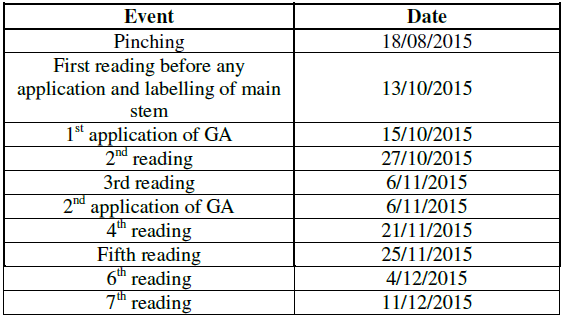
Table 1. The dates of all the interventions that took place in the greenhouse
Height of the main branch
The height of the main branch in each of 420 poinsettia plants, was measured using a ruler from 13 October 2015 to 11 December 2015. All plants in the 7 blocks showed an increase in the main branch height as shown in figure 3. The height of the main branches of plants in blocks T, A and B increased from around 11.32 cm at the beginning of the experiment to almost 18.48 cm at the end of the experiment whereas block C plants showed an increase in the height of the main branch reaching 24.53 cm. The main branches height of blocks A’, B’ and C’ plants reached at the end of the experiment were 18.96 cm, 21.82 cm and 33.83 cm respectively.
ANOVA showed that the difference in main branches height measured in block C plants (50 ppm GA) was significant (P<0.05) when compared with values in blocks T, A and B. In parallel, the maximum height of the main branches (33.83 cm) measured in blocks C’ plants treated twice with 50 ppm GA was also significantly different at P <0.05 when compared to all other treatments.
These results are consistent with those of [13] who suggested that an increase in main branch height can be attributed to the use of GA. Similarly, [14] reported, while comparing 2 concentrations of GA (50 ppm and 100 ppm), that the height of the main stem was highest after 100 ppm application of GA which is in accordance with our results Our results confirmed this study where the maximum height was obtained in the treatments that received twice the highest concentration (50 ppm).
Diameter of the main branch
An increase in the diameter of the main branches was observed in the 420 poinsettia plants. In fact, the measured diameters were between 0.08 and 0.09 cm on October 13, 2015 and between 0.14 and 0.15 cm on December 11, 2015 independently of the treatment applied. These differences in diameter measurement were not significant among all treatments at P>0.05.
These results are consistent with those of [15] who and while comparing the diameters of the main branches after a single application of 50 or 100 ppm found that these concentrations did not cause a significant difference to 5% compared to control plants.
Number of lateral shoots
The number of lateral shoots was counted in all the blocks T, A, B, C, A’, B’ and C’ during the whole period of the experiment. At the end of the experiment, the results obtained showed that the hormone did not influence the number of lateral shoots because their number varied between 2 on 13th of October 2015 and 5 on 11th of December 2015 and that independently of the hormone dose sprayed (Figure 4).These results have been confirmed by the ANOVA which showed no significant difference at P <0.05 among all treatments.
The number of lateral shoots was significant after pinching in an experiment performed by [15] without GA application compared to control plants. Our results, which did not show a significant increase in lateral shoots, may be due to spraying GA, which could have inhibited their appearance. On the other hand, the study carried out by [12] are in accordance with our results as there was not a significant difference in number of lateral shoots between the plants sprayed once or twice by 5ppm GA and the control plants. Our results of the lateral shoots number, even though it is low (5 at the end of the experiment) does meet the market demands according to [16] where 5 shoots for Euphorbia pulcherrima plants are required.
Number of bracts per shoot
The results obtained revealed that gibberellic acid and regardless of the concentration used has no effect on the number of bracts per shoot as the number remained between 4 and 5 during the whole period of the experiment. On the other hand, a study made by [17] reported that gibberellic acid decreases the number of flowers on poinsettia. The non-compliance between our studies may be due to the difference in concentration used in each experiment.
Correlation between studied parameters
The correlation was studied (Spearman test) to determine the relationship between all tested parameters throughout the experiment period. The correlation at P<0.05 and P<0.01 among all parameters is shown in Tables 2, 3, 4, 5, 6, 7 and 8.
In the block T, as shown in Table 2, the height of the plant had a strong positive correlation with the height of the main branch at P<0.01. So, when the height of the plant increases, the height of the main branch and its diameter also increase. On the other hand, the diameter of the main branch had a strong positive correlation at P<0.001 with the height of the main branch, so its increase leads to the increase of the aforementioned parameter.
In block A, the height of the plant had a strong positive correlation with the height of the main branch and its diameter at P<0.001. So, when the height of the plant increases, the height of the main branch and its diameter also increase. On the other hand, the diameter of the main branch had a positive correlation at P<0.05 with the height of the main branch. The number of lateral shoots had a positive correlation at P<0.05 with the number of bracts per shoot, so it increases when the latter increases (Table 3).
In block B (Table 4), the height of the plant had a strong positive correlation with the height of the main branch and its diameter at P<0.001. Therefore, the increase in the height of the plant causes the increase of the above-mentioned parameters. On the other hand, the diameter of the main branch had a strong positive correlation at P<0.001, with the height of the main branch. The number of lateral shoots had a strong positive correlation at P<0.05 with the number of bracts per shoot, so it increases when the latter increases.
In block C, the height of the plant had a strong positive correlation at P<0.01 with the height of the main branch as shown in Table 5.
In block A', as shown in Table 6, the height of the plant had a strong positive correlation at P<0.001 with the height of the main branch. The number of lateral shoots was positively correlated at P<0.05 with the number of bracts per shoot.
In block B’, the height of the plant had a strong positive correlation at P<0.001 with the height of the main branch as well as a positive correlation at P<0.05 with the number of young plants. So, when the height of the plant increases, the height of the main stem, and the number of lateral shoots, also increase. The height of the main branch had a positive correlation at P<0.05 with the number of young shoots (Table 7).
In block C', as shown in Table 8, the height of the plant had a strong positive correlation at P<0.001 with the height of the main branch, as well as a positive correlation at P<0.05 with the number of lateral shoots. The height of the main branch had a positive correlation at P<0.05 with the number of lateral shoots. The number of lateral shoots was positively correlated to P<0.005 with the number of bracts per shoot.
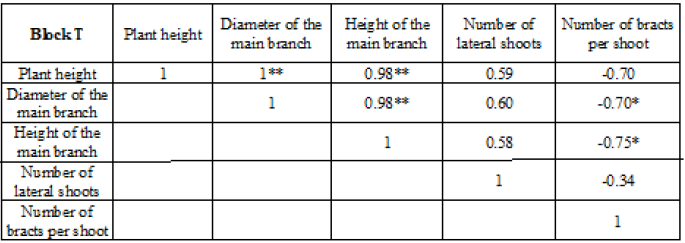
Table 2. The correlation between the measured parameters of block T
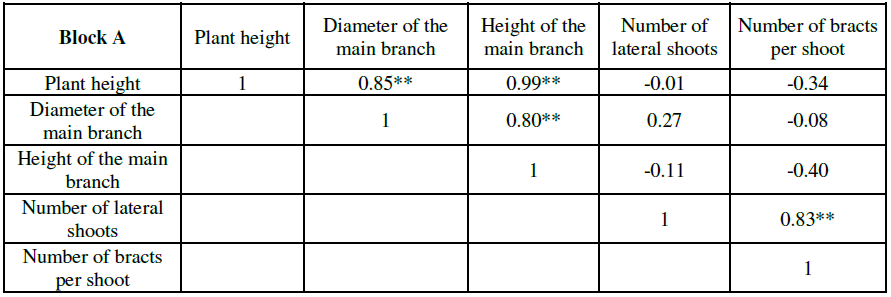
*- significant at P< 0.05 **- significant at P< 0.001
Table 3. The correlation between the measured parameters of block A
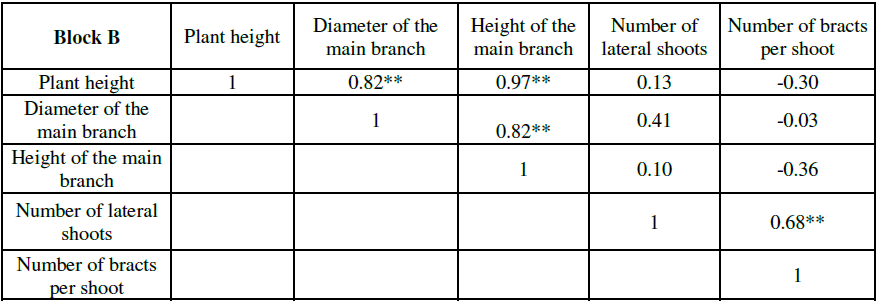
*- significant at P< 0.05 **- significant at P< 0.001
Table 4. The correlation between the parameters measured of block B
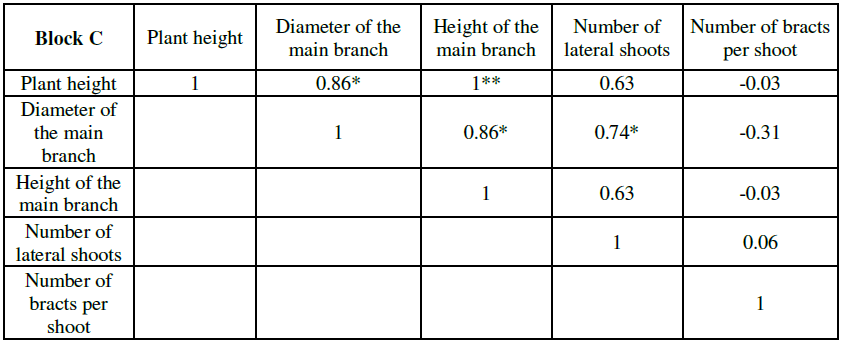
*- significant at P< 0.05 **- significant at P< 0.001
Table 5. The correlation between the measured parameters of block C
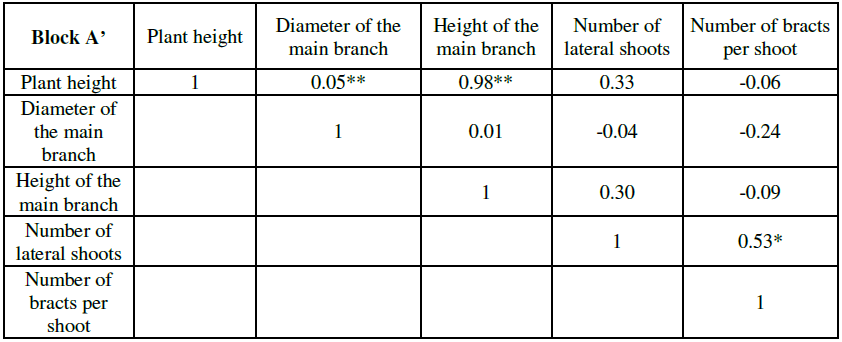
*- significant at P< 0.05 **- significant at P< 0.001
Table 6. The correlation between the measured parameters of block A’
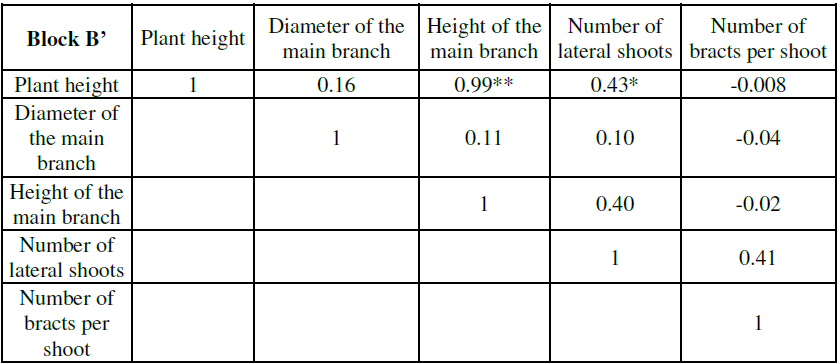
*- significant at P< 0.05 **- significant at P< 0.001
Table 7. The correlation between the measured parameters of block B’
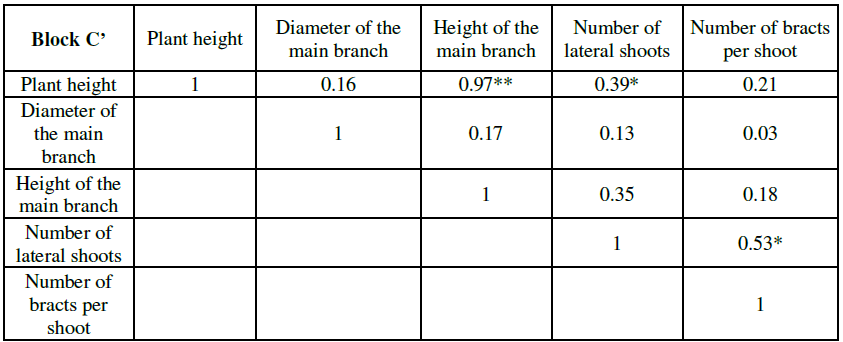
*- significant at P< 0.05 **- significant at P< 0.001
Table 8. The correlation between the measured parameters of block C’
CONCLUSIONS AND RECOMMENDATION
The fact that everyone has his one taste in choosing the type, the color and the size of the potted plant of poinsettia drove us to conduct this study. Worldwide poinsettia is preferred little compacted, about 50 cm, but in some countries like Lebanon, poinsettia is preferred longer, and as it grows longer its price increases. Therefore, growers are now working on increasing poinsettia size by horticultural or chemical methods to match the local style.
This study was conducted on a variety of poinsettia (Freedom Red cultivar) imported from Italy and grown in a greenhouse under controlled conditions in the Damour region to test the effect of different doses of gibberellic acid applied early in the season and later on the performance of poinsettia. Four hundred and twenty plants were divided into seven blocks, each one constituting a treatment, each was repeated four times and several parameters were measured: the height of the plant, the height of the main branch, its diameter, the number of young shoots and the number of bracts per shoot. The results revealed that one application of the hormone earlier (October 13, 2015) strongly influenced the height of the plant if applied at high concentration (50 ppm). A second dose applied after 3 weeks of the first spray did not increase the plants height significantly unless GA is applied at 50 ppm. The hormone influenced the height of the main branches, two concentrations of 50 ppm one applied early (mid-October), the other after 3 weeks increased the height of the branches strongly (33.83 cm). In addition, the correlation study showed that the height of the plant had a strong positive correlation (P <0.001) with the height of the main branch.
The present work is the first of its kind in Lebanon since the growers usually used to use growth retardants to manage the plant height or they do not use any chemical hormones in case they want the plant to be a little longer. Besides, some parameters were measured for the first time worldwide, since it can be seen clearly in all the scientific articles [8, 9, 10, 14, 15], having similar topic that they concentrated on testing the effect of the hormones on the plant height, number of lateral shoots and the flower diameter mainly.
In later studies, the effect of gibberellic acid and other growth hormones could be applied to measure other parameters such as leaf area, bract diameter, and color intensity. Similarly, it is advisable to make two pinches instead of one to clarify the effect on the height and size of the poinsettia.
REFERENCES
- Ecke, P., Faust, J., Williams, E., Higgins, A. 2004. The Ecke poinsettia manual. 3rd Ed.1-7.
- Jasrai, Y. T., Thaker, K.N., Dsouza, M.C. 2003. In vitro propagation of Euphorbia pulcherrima through somatic embryogenesis. Plant Tissue Culture, 13(1), pp. 31-36.
- Clarke, J. L., Carl, S., Sissel, H. 2008.Agrobacteriumtumefactions-mediated. Transformation of poinsettia, Euphorbia pulcherrima, with virus-derived hairpin. Plant Cell Rep, 27(6), pp. 1-27-1038.
- Seltzer, D.E., Spinner, M. 2016."Poinsettia Facts".Master Gardeners, University of Illinois Extension Master Gardeners, University of Illinois Extension.
- El Khoury, R. 2014. Personal communication
- Mata, D., Botto, J. 2009. Manipulation of Light Environment to Produce High-quality Poinsettia Plants. Hortscience, 44 (3), pp. 702–
- Lopes, , Stack, L.S. 2003. 2003-2004 New England Greenhouse Floricultural Recommendations. A management guide for insects, diseases, weeds and growth regulators New England Floriculture, Inc., 250 pp.
- Blanchard, M., Olrich, M., Runkle, E. 2005. Fascination on Poinsettia. GPN magazine, 380, pp. 1-3.
- Runkle, E. 2007. Increasing poinsettia size. GPN magazine, pp. 66.
- Blanchard, M., Runkle, E. 2008. Increasing stem elongation and bract size of poinsettia freedom red with gibberellins and benzyladenine. Acta horticulture, 774, pp. 209-215.
- Campbell, N., Reece, A., Jane B., Urry, L.A., Cain, M.L., Wasserman, S.A., Minorsky, P.V., Jackson, R.B. 2013. Biology (10th edition). San Francisco: Pearson, Benjamin Cummings. pp. 1488.
- Nasser El-Deen, S. 2015."Effect of gibberellic acid and cytokinin on the growth of Euphorbia". Diploma of Agricultural Engineer, Faculty of Agriculture, Lebanese University, pp. 71.
- Evans, M., Wilkins, H., Hackett, W. 1992. Gibberellins and temperature influence long-day floral initiation in poinsettia. Society of Horticultural Sciences, 117(6), pp. 966-971.
- Ramtin, A., Khalighi, A., Hadavi, E., Hekmati, J. 2011a. Effect of different IBA concentrations and types of cutting on rooting and flowering Poinsettia pulcherrima International Journal of Agri Science, 1(2), pp. 52-16.
- Ramtin, A., Khalighi, A., Hadavi, E., Hekmati, J. 2011b. “Effects of pinching and Gibberellic Acid on increasing the number of cutting from Poinsettia pulcherrima. International Journal of Agri Science, 1(5), pp. 303-310.
- Faust, J., Heins, R. 1996. Axillary bud development of Poinsettia ‘Eckespoint Lilo’ and ‘Eckespoint Red Sails’ (Euphorbia pulcherrima) is inhibited by high temperatures. Journal of American Society of Horticulture Sciences, 121, pp. 920-926.
- Odula, F. 2011. "Effects of temperature, light and plant growth regulators on fuel-efficient poinsettia production". The Graduate School of Clemson University. Thesis of the requirements for the Masters of Science Degree in Plant and Environmental Science (http://tigerprints.clemson.edu/all_theses).


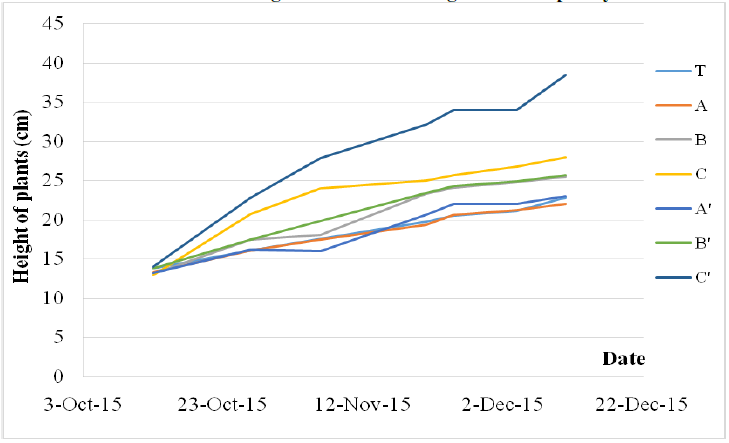
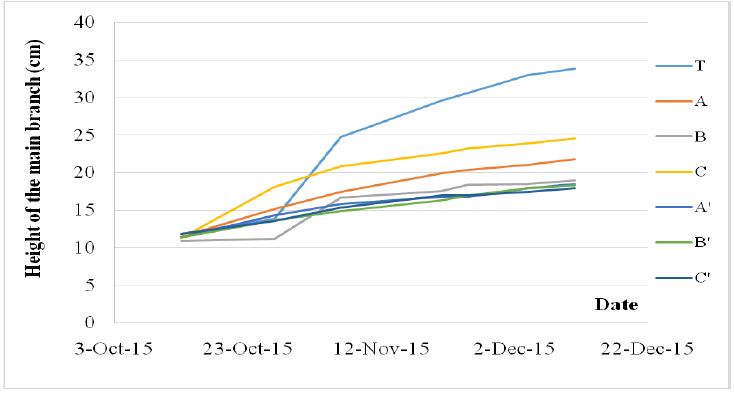
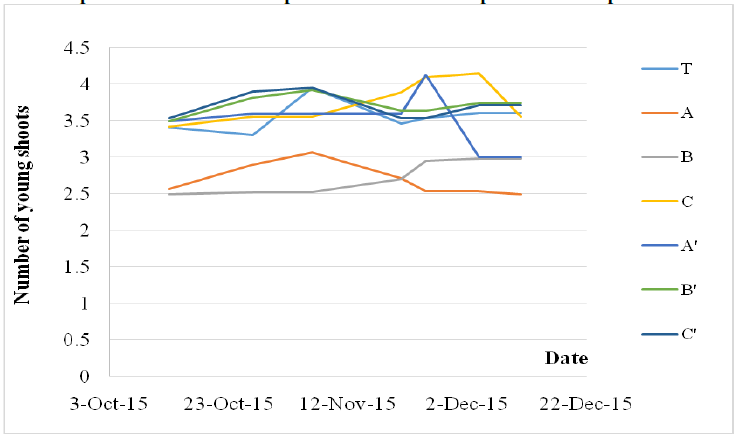

 Impact Factor: * 4.1
Impact Factor: * 4.1 Acceptance Rate: 75.32%
Acceptance Rate: 75.32%  Time to first decision: 10.4 days
Time to first decision: 10.4 days  Time from article received to acceptance: 2-3 weeks
Time from article received to acceptance: 2-3 weeks 